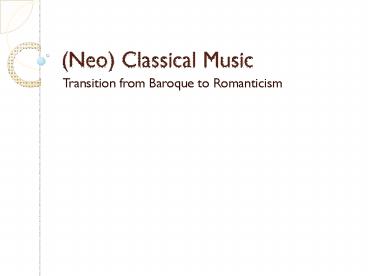(Neo) Classical Music - PowerPoint PPT Presentation
Title:
(Neo) Classical Music
Description:
... Opera The Marriage of Figaro Don Giovanni The Magic Flute Ludwig Van Beethoven ... Mozart Ludwig Van Beethoven Beethoven PowerPoint Presentation ... – PowerPoint PPT presentation
Number of Views:178
Avg rating:3.0/5.0
Title: (Neo) Classical Music
1
(Neo) Classical Music
- Transition from Baroque to Romanticism
2
Neo? Classical
- Although the following developments happened
during the time period we are calling
Neoclassical in class, this period in music is
most often referred to in modern times as simply
Classical - It is important to note that Classical music in
todays culture is regarded as a genre as well as
a time period. Not all music labeled as
Classical was composed during this period.
3
Remember the Baroque
- The Baroque period was known for its
ornamentation. - Polyphony (many melodic lines at once) was a
predominant feature of Baroque Music. - Opera Seria was the most common form of opera at
the time.
4
Shifting to the Classical
- Like in other art forms during this period an
order and clarity was brought to music. - Polyphony was replaced by Homophony
- Homophonic music is characterized by a singular
melody over a subordinate (or supporting)
harmony. - This allowed the tonal structure of works to
become more audible. - This created the need for notating the melodic
line for dynamics and phrasing.
5
Opera
- Public taste shifted from Opera Seria to Comic
Opera. - The music of Comic Opera was usual much simpler.
- The story usually focused on ordinary people
rather than grand historical figures.
6
Instrumental Music
- The fortepiano (the precursor to the modern
piano) replaced the harpsichord. - (The fortepiano is the piano like instrument seen
in the film Amadeus with the reversed black and
white keys and the lighter sound of our modern
pianos) - Main types of instrumental music were sonata,
trio, string quartet, symphony, concerto,
serenade and divertimento
7
Sonata Form
- The Sonata Form developed during this time.
- NOT to be confused with a Sonata
- The Sonata Form was a way of structuring the
first movement in a multi-movement composition. - Also called First movement form and Sonata
Allegro Form since the first movement is usually
in an allegro tempo
8
Sonata Form continued
- The main parts of the Sonata Form are
- Introduction- optional
- Exposition- introduction of theme (perhaps a
melody) - Development- playing around with themes form the
exposition - Recapitulation- return to the Exposition but
altered slightly (for emphasis) - Coda- tag
9
Symphony
- Composed for full orchestra
- 3-4 movements
- 1st and 4th movement always fast.
- 1st Movement- sonata or allegro
- 2nd Movement- a slow movement or adagio
- 3rd Movement- a minuet with trio or Beethoven 4
movement solo sonata - 4th Movement- an allegro, rondo or sonata.
10
Wolfgang Amadeus Mozart
- 1756-1791
- Born is Salzburg (what is now Austria)
- Child prodigy, began composing at the age of 5
- Composed for a variety genres including
- Opera, sonata, piano concertos, symphony, string
quartet, chamber music, dance music, solo piano.
11
Mozart
- Most famous works
- Eine Kleine Nachtmusik
- Piano Concerto 21
- Requiem Mass (unfinished)
- Opera
- The Marriage of Figaro
- Don Giovanni
- The Magic Flute
12
Ludwig Van Beethoven
- German composer, born in late 1700s
- Most famous for continuing to compose music even
after going completely deaf - Also wrote for a variety of genres
- Very important to the development of music. He
is regarded as the connection between the
(Neo)classical period and the Romantic Era.
13
Beethoven
- Most famous works
- Fur Elise
- 9th Symphony Ode to Joy
- Moonlight Sonata
14
- Mozart and Beethoven are two of the most famous
composers of all time. - Although you may not have recognized the tunes
played by name you probably recognize the tunes. - Their tunes are used frequently in movies, TV
etc. - (Beethovens Moonlight Sonata actually appears in
Youre A Good Man Charlie Brown)

